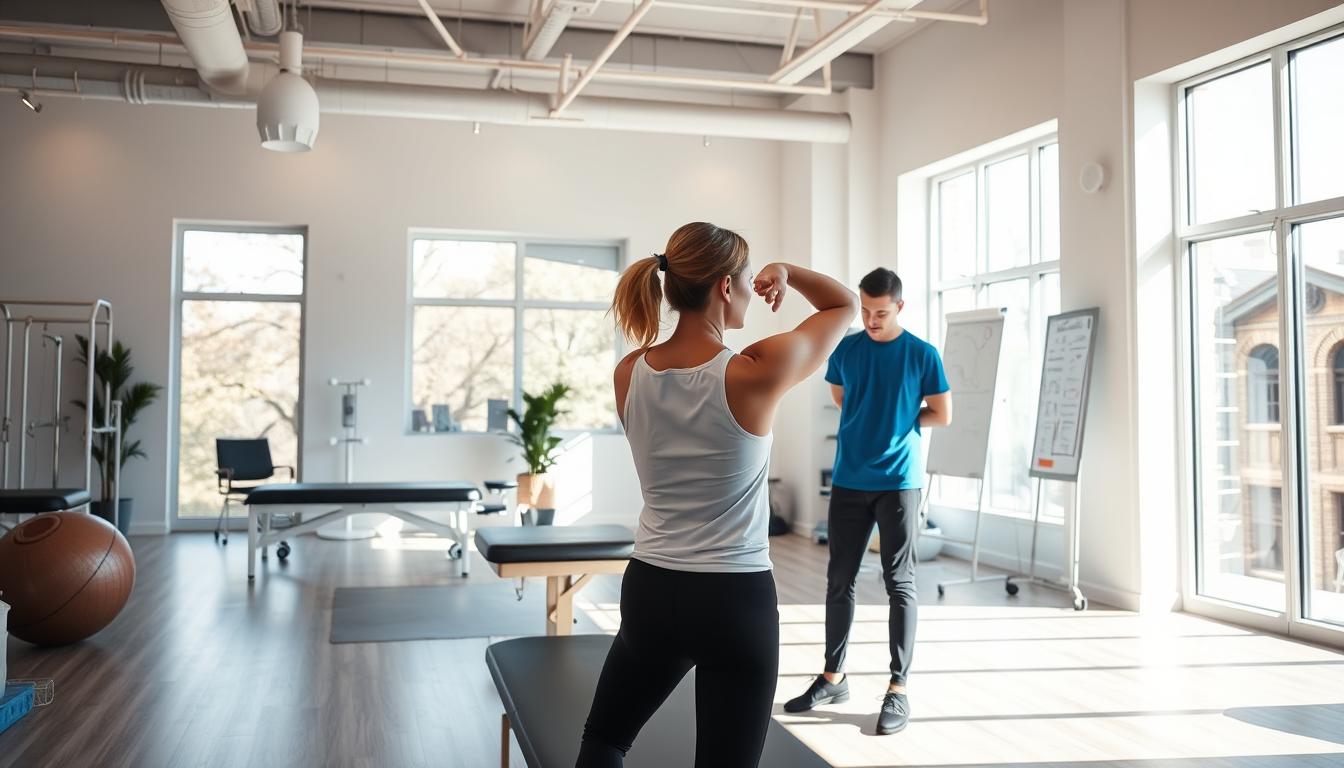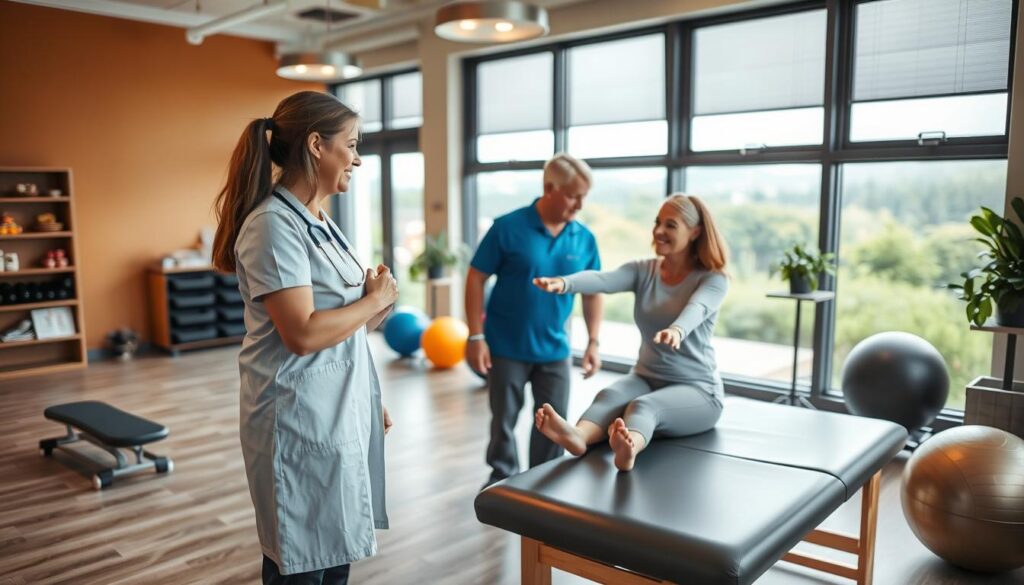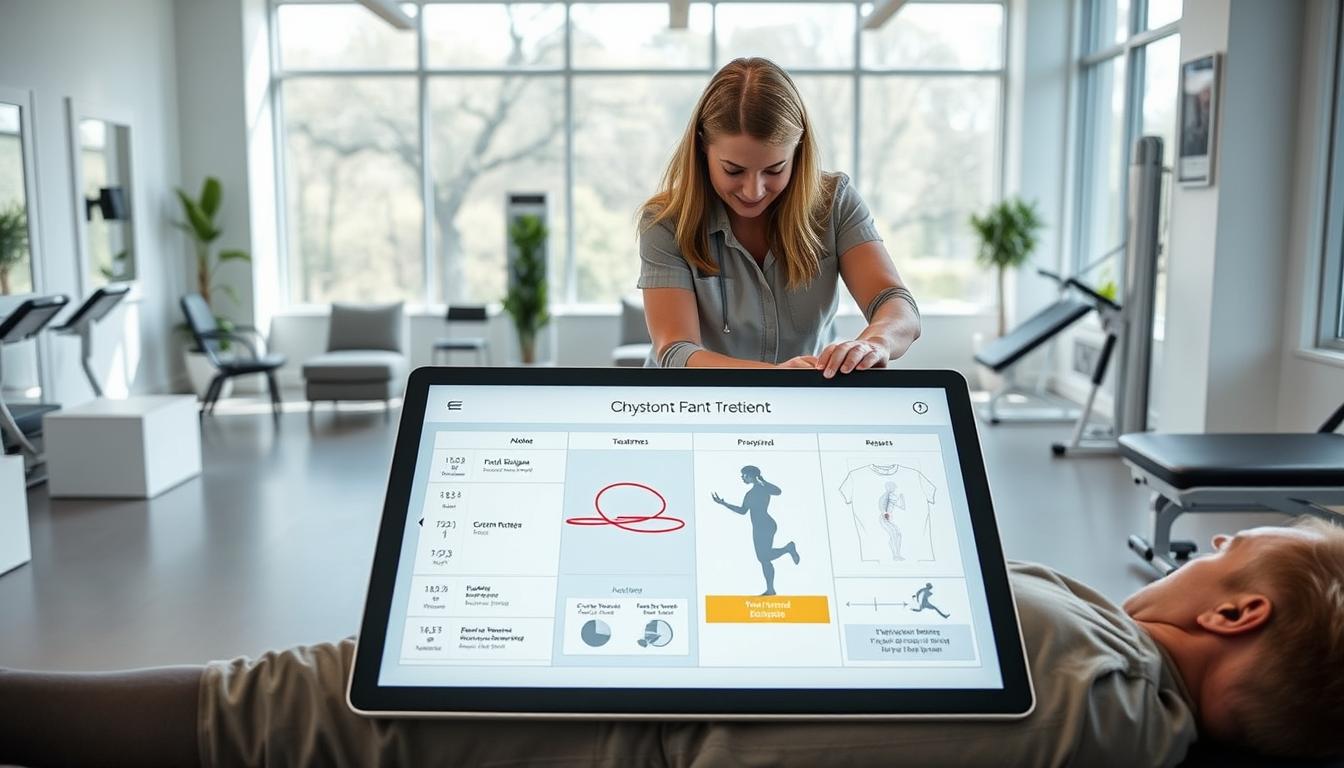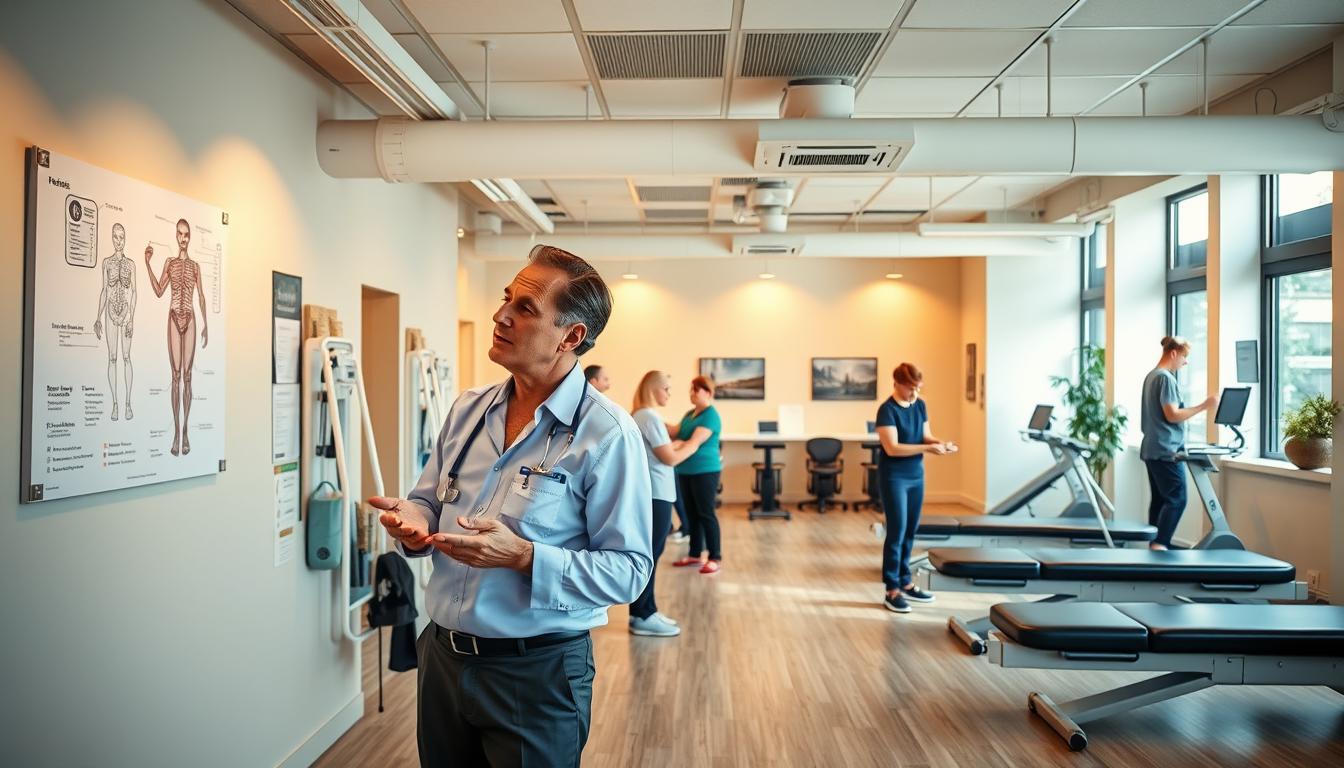Did you know physical therapy can cut treatment costs by 72%? This amazing fact shows just one of the many benefits of physical therapy. Many people don’t know that it helps with recovery and keeps you healthy for life.
Imagine not having to take medication for pain. Physical therapy makes this a reality for many. It helps athletes, seniors, and those with chronic health issues feel better without surgery or opioids12.
We’ll look at how physical therapy works and who it’s for. You’ll learn about its benefits, the treatments used, and who gets the most from them.
Get ready to become a healthier, more mobile version of yourself. We’ll explore the key benefits of physical therapy.
Key Takeaways
- Physical therapy can help relieve pain without medication.
- It’s great for getting back on your feet after injuries or surgeries.
- PT offers plans made just for you.
- It helps prevent injuries with special assessments.
- It can lower healthcare costs and improve results.
- It’s good for managing long-term conditions like arthritis and back pain.
Introduction to Physical Therapy
Physical therapy is a key part of healthcare. It helps people move better and recover from injuries. It uses special exercises and methods to ease pain and improve life quality.
Many people benefit from physical therapy. This includes athletes, those recovering from surgery, and older adults. It helps them regain their strength and mobility.
What is Physical Therapy?
Physical therapy combines hands-on care, exercises, and education. It treats many health issues. Physical therapists are experts who create treatment plans for each patient.
They work in many places, like clinics and sports centers. This makes sure everyone can get the care they need. Studies show it can help manage pain and reduce opioid use, which is good for the opioid crisis.
Who Can Benefit from Physical Therapy?
Many people can benefit from physical therapy. Athletes use it to heal from injuries and get better. Seniors can stay mobile and independent with the right therapy.
Those with chronic pain or recovering from surgery see big improvements. The CDC says it’s a safer choice than surgery for many issues. Starting treatment within 28 days is key to getting the best results.
Key Benefits of Physical Therapy
Physical therapy can change your life for the better. It helps with pain, improves how you move, and supports your recovery. It’s key to getting back to full health.
Pain Relief Without Medication
Physical therapy is a great way to manage pain without drugs. It uses methods like manual therapy and electrical stimulation. These methods help reduce pain, with 90% of patients feeling better after therapy3.
This is a safer choice than opioids, which can lead to addiction4.
Faster Recovery from Injuries
Physical therapy speeds up healing from injuries. Studies show that 75% of patients regain function after surgery3. It creates a plan just for you, helping you get back to your activities faster, including sports5.
Improved Mobility and Flexibility
Regular physical therapy boosts your mobility and flexibility. About 80% of patients see better balance and mobility3. This makes daily life easier and more enjoyable, helping with conditions like knee osteoarthritis5.
Prevention of Future Injuries
Physical therapy helps prevent injuries too. It spots and fixes movement problems, making you safer and more efficient3. In fact, 95% of people see big improvements, lowering their risk of future injuries3.
Benefits of Physical Therapy for Chronic Conditions
Living with chronic conditions like arthritis and back pain is tough. Physical therapy is key in managing pain and improving life quality. It offers tailored exercise plans to ease symptoms and boost mobility, making daily tasks simpler.
Management of Arthritis and Back Pain
About 50 million adults in the U.S. face chronic pain, including arthritis and back pain, as the CDC reports4. Physical therapy for arthritis creates personalized treatment plans to manage symptoms effectively6. Patients learn exercises and stretches for long-term pain relief, boosting overall health4.
With better range of motion, people can do more in their daily lives.
Support for Post-Surgery Rehabilitation
Physical therapy is also vital for post-surgery recovery. After surgeries like joint replacements, patients get therapy to regain strength and function. Physical therapists use special techniques to lessen pain and aid healing, which is essential for a smooth recovery6.
Customized rehab programs help you move safely and quickly, speeding up your return to normal life.
Enhanced Athletic Performance Through Physical Therapy
Physical therapy is key for better athletic performance and injury prevention. It offers recovery programs tailored to each athlete. These programs help not just in getting better but also in reaching new heights in sports.
It’s all about performance, not just recovery. This approach helps all athletes, from beginners to pros. It keeps injury prevention at the forefront of training.
Targeted Recovery for Athletes
Physical therapy programs are made just for each athlete. They consider goals, skills, and more. This shows how care is tailored for each athlete7.
Physical therapists use their knowledge to improve technique. This leads to better control and coordination. Strength training is also key for muscle building and injury prevention7.
Early spotting of problems by physical therapists can stop injuries. They focus on imbalances before they become big issues7. Flexibility training is also important for agility and resilience7.
Proper warm-up and cool-down techniques taught by physical therapists also help. They reduce injury risks during sports7.
Injury Prevention Techniques
Physical therapy is a strong tool for preventing injuries, mainly in high-impact sports8. It helps build muscle strength and endurance. It also boosts agility and speed8.
This approach helps athletes avoid missing training and competitions. It’s all about being proactive8.
Therapy also offers emotional support, reducing stress and anxiety. This boosts motivation and confidence in athletes8. Regular checks help spot injury risks early, leading to long-term prevention8.
By adding physical therapy to training, athletes can perform better and stay injury-free. It’s a path to success8.
How Physical Therapy Works
Physical therapy is effective for many reasons. It offers different treatments for various needs. Whether you have muscle or nerve problems, or need help after surgery, there’s a therapy for you.
Types of Physical Therapy
Physical therapy has many special areas:
- Orthopedic PT
- Neurological PT
- Pediatric PT
- Cardiovascular and pulmonary PT
- Pelvic floor rehabilitation
- Sports PT
- Vestibular and balance therapy
- Wound care therapy
Each type targets specific issues. They use different methods to help you heal and recover.
What to Expect in a Physical Therapy Session
A typical session starts with a detailed check-up. Your therapist will then make a plan just for you. This plan might include:
- Targeted exercises
- Manual therapy techniques
- Education on managing your condition
These sessions are designed to help you get better fast. Studies show that 80% of patients see better mobility and less pain after therapy9. It’s important to listen to your therapist to avoid injury10.
Who Should Consider Physical Therapy?
Physical therapy is great for people with health issues. If you have ongoing pain or find daily tasks hard, it’s time to think about PT. A physical therapist can help you get stronger and move better.
Signs Indicating You Need PT
- You struggle with persistent pain, which may keep you from enjoying life to the fullest.
- Limited mobility or flexibility hinders your ability to perform everyday tasks.
- You have ongoing issues related to sports injuries that don’t seem to improve.
- Recovering from surgery and seeking effective rehabilitation.
- You notice recurring discomfort in areas like your back, knees, or joints, suggesting underlying issues.
Common Conditions Treated with PT
PT helps with many common issues. It’s good for arthritis, back pain, rotator cuff tears, and sciatica3. It’s for everyone, from kids to seniors, to make life better11. You can even go to a PT on your own, making it easier to get help when you need it11.
Benefits of Physical Therapy in Daily Life
Physical therapy can greatly improve your daily life. Regular sessions help with posture and body mechanics, keeping your muscles and joints healthy. Good posture reduces muscle and joint strain, making life better.
Studies show physical therapy can cut chronic pain by up to 70%. This is a big win for those dealing with pain every day12. It not only fixes current problems but also helps prevent future injuries, leading to a healthier life.
Physical therapy also boosts your physical activity. About 30% of patients see better mobility after therapy12. This makes your daily life more active and enjoyable.
It also improves balance and coordination, key for daily tasks, even as you get older. Targeted exercises can lower the risk of falls, vital for seniors13. Physical therapy is a key to a healthier, more active life.
Why Physical Therapy is Important for Seniors
Physical therapy is key for seniors to live better lives and stay independent. It helps them move better and fall less. About 1 in 3 older adults fall each year, showing the need for good fall prevention14.
Physical therapy makes muscles stronger, balance better, and coordination sharper. This means seniors can move around more easily.
Maintaining Independence and Mobility
Keeping independence is essential for seniors’ happiness. Physical therapists create plans to boost strength and movement. This is important as muscles and bones get weaker with age15.
Regular therapy keeps strength and mobility up, helping seniors stay independent15. Starting physical therapy early is important. It helps prevent big losses in strength and mobility, letting seniors move around confidently.
Fall Prevention Strategies
Keeping seniors safe from falls is critical. The Otago exercise program can cut falls by up to 50%16. Physical therapists teach safe movement, giving seniors the tools to avoid risks.
Adding preventive exercises to routines can greatly improve strength and balance. This supports fall prevention efforts14. By focusing on physical therapy, seniors can greatly reduce fall risks and live a healthier, more active life.
Tips for Getting the Most Out of Physical Therapy
To get the most from physical therapy, focus on a few key areas. First, find a physical therapist who knows your condition well. This is key for the best results. Before your sessions, write down your symptoms, medical history, and any questions you have. This helps your therapist understand your needs better17.
Finding the Right Physical Therapist
Choosing the right physical therapist is important. Look for someone with experience in your condition. Good communication with your therapist is also key. Studies show that talking openly can increase your chances of success by 40%18.
Setting clear goals is also important. Patients who have specific goals are 70% more likely to succeed18.
Staying Consistent with Exercises
Being consistent is vital for the best results. Sticking to your exercise plan can speed up recovery by 30%18. Also, showing up for every session can increase your chances of success by 30%17. Doing exercises at home can make you recover 25% faster17.
Understanding Physical Therapy Techniques
Physical therapy uses many techniques to help patients feel better and recover. Knowing the difference between manual therapy and exercises, and the benefits of hydrotherapy, helps you choose the right treatment. This knowledge is key to making informed decisions about your care.
Manual Therapy vs. Therapeutic Exercises
Manual therapy uses hands-on methods to work on muscles and joints. It can quickly ease pain by improving blood flow and reducing muscle tightness by up to 50%19. When combined with exercises, it boosts strength and mobility by up to 35%19.
This mix of manual therapy and exercises leads to better function and movement. It helps you recover more fully.
Hydrotherapy and Its Benefits
Hydrotherapy uses water’s healing properties, making it great for those who have trouble moving. It helps ease joint pressure while you move. This method is key in your recovery, reducing pain and improving mobility without harming your joints.
People who try hydrotherapy see big improvements in their physical function. It’s a valuable part of a complete treatment plan.
Understanding these physical therapy methods shows how they help improve your treatment outcomes5. Care from licensed physical therapists means you get plans made just for you5.
Advantages of Seeing a Physical Therapist
Seeing a physical therapist has many benefits. They create care plans just for you, based on your needs. This helps you recover physically and improves your emotional health too.
Personalized Care Plans
Physical therapy is all about custom plans. They look at your health history, goals, and lifestyle. This makes your treatment more effective.
You’ll usually see your therapist 2-3 times a week for 4-8 weeks. This helps you get better slowly but surely. Unlike medicine, physical therapy tackles the root of your pain20.
The Emotional and Mental Benefits of PT
Physical therapy also boosts your emotional health. It makes you feel more in control and confident. You’ll feel better about moving around.
Doing exercises at home is easy, taking just 10 minutes a day. This helps your mental health without being too much21. Physical therapy is a complete way to heal, both physically and emotionally.
Conclusion
Physical therapy does more than just help you get better after an injury. It also helps manage pain, improve how you move, and boost your sports skills. Many people use it to deal with long-term issues like arthritis and back pain, cutting down on medication use.
By joining a custom physical therapy program, you can heal faster. You’ll also get stronger and more energetic. These are key for staying active as you get older2223.
Thinking about your health? Remember, physical therapy is a smart way to stay well. Regular sessions can make you more balanced and less likely to fall, which is great for older folks23. It lets you reach your body’s full healing power and live better.
Choosing to add physical therapy to your life is a big step towards better health. It’s about understanding how a plan made just for you can change your life for the better. This shows why physical therapy is so important in healthcare today2223.
FAQ
What are the benefits of physical therapy?
Physical therapy helps with pain, improves movement, and speeds up recovery. It also boosts athletic performance and manages long-term health issues. This leads to a better life overall.
Who can benefit from physical therapy?
Many people can benefit from physical therapy. This includes athletes recovering from injuries, seniors wanting to stay mobile, and those with chronic pain or after surgery.
How does physical therapy help with pain management?
Physical therapy offers pain relief without drugs. It uses exercises and hands-on methods to ease discomfort and improve how you move.
What can I expect in a physical therapy session?
In a session, you’ll get a detailed check-up and personalized exercises. You’ll also learn new ways to move and get educational tips to help your recovery.
Why is physical therapy important for seniors?
Physical therapy is key for seniors. It keeps them mobile, improves balance, and teaches safe movement. This reduces the risk of falls.
What types of conditions can physical therapy treat?
Physical therapy can help with many conditions. This includes arthritis, back pain, sports injuries, and post-surgery recovery. It also helps with neurological disorders.
How can physical therapy improve athletic performance?
Physical therapy boosts athletic performance by creating recovery plans. It improves strength, flexibility, and endurance. It also teaches injury prevention to keep athletes competitive.
What should I consider when choosing a physical therapist?
When picking a physical therapist, look at their qualifications and specialty. Make sure they create a treatment plan that fits your goals.
How can I maximize my physical therapy experience?
To get the most from physical therapy, stick to your exercises and talk openly with your therapist. Being active in your recovery plan helps too.
What are the emotional benefits of physical therapy?
Physical therapy can improve your mood by reducing anxiety about moving. It boosts confidence in your physical abilities, leading to a better life.
James Foster, PT is a licensed physical therapist with over 11 years of hands-on experience in helping individuals improve mobility and live pain-free. As a health writer, James shares expert advice, rehabilitation strategies, and wellness tips to empower readers toward healthier, stronger lives.





